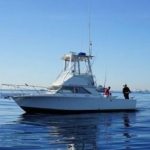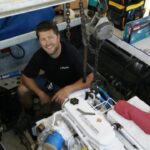Cummins Marine Diesel Repower Specialists › Forums › General Discussion › Max power curve question
- This topic has 17 replies, 5 voices, and was last updated 6 years ago by
 Bill Fuller.
Bill Fuller.
-
CreatorTopic
-
September 27, 2017 at 7:34 am #23321
I see statements that claim that unless you can reach the rated power RPM that you are over propped at any RPM.
If so then I don’t understand the max power curve because that curve would seem to be the max power the engine can produce at every RPM.
If I propped a 400 HP rated engine to the 200 HP rpm point and made that the max operating RPM wouldn’t I have in effect simply de rateted the engine to 200 HP and would be within safe operating parameters?
-
CreatorTopic
-
AuthorReplies
-
October 1, 2017 at 10:23 am #23474

Bill FullerParticipantVessel Name: Audax
Engines: Yanmar 4LHA-STE
Location: San Diego, CA
Country: USA
BruM
One other thing for you to contemplate.
The max HP curve is generated making measurements from right to left, not left to right.
The first measurement is made at 3065 RPM for our QSB-230 example.
Bill F.October 1, 2017 at 9:18 am #23473
Bill FullerParticipantVessel Name: Audax
Engines: Yanmar 4LHA-STE
Location: San Diego, CA
Country: USA
BruM,
If you are still here, I have one (maybe more) question.
How would you load the QSB-230 to produce 155 HP at 1600 RPM in real life? Physically, how would you manage to obtain this result? Add pitch to the props? About the only way I know of.
Back to Tony’s fundamental question. What engine(s) and boat do you have. And what would you like to change to obtain a result along the lines that you are proposing? I would love to see an experiment where you actually make these changes and then report back with the results.
FYI, max HP (torque), full throttle HP (torque), wide open throttle HP (torque) all mean the same thing. Nothing unusual about that.
So, please come back with your personal boat specs and what you want to do with it.
Also, I suggest you go to the internet and look at some dyno test so as to have an idea of how the max HP curve is obtained.
Bill F.
October 1, 2017 at 7:57 am #23471
Tony AthensModeratorVessel Name: Local Banks
Engines: QSB 6.7 550 HP
Location: Oxnard, CA
Country: USA
Zero argument on that..
Curious——— what type of boat & engines do you have?
Located where?
Tony
October 1, 2017 at 7:44 am #23470Thanks Tony. Clearly more complex than I figured. Have to quit for now.
I still think compression ignition is an elegant concept.
September 30, 2017 at 2:45 pm #23454
Tony AthensModeratorVessel Name: Local Banks
Engines: QSB 6.7 550 HP
Location: Oxnard, CA
Country: USA
Send me those 2 curves on the 400 HP & 200 HP engines….
Also why terms “destruction” & “destroy” ? I do not think that is coming from us.. Where else has your reading taken you that this is what happens on the dyno or in use? ..
As to your conclusion that a QSB 5.9 running at 1600 RPM and producing 155HP is a continuous operating level and be an acceptable operating point…………….. You are completely out of touch with what Cummins would even get close to agreeing with as the BMEP at 1600RPM producing 155HP would thermally overload the engine and dramatically shorten it’s life. I am also sure Cat, Volvo & FPT would say the same for any of there engines in that class too .. Move that RPM up to the 2000-2200 RPM range and load to 155HP and now the BMEP would drop into an acceptable range in that particular engine….Plus, you are not even considering the other extremely important parameters that come with the increased RPM — Piston cooling, overall oil cooling, and coolant & / or seawater circulation, etc..
Remember this if nothing else– Just because an engine “could” , does not mean it “should”–And also, I do not think you really understand what Cummins means as to the term “Continuous Duty” and comes along with that.
If this is how you will continue to think and interpret Cummins Power curves, maybe I can’t help as you are wrong in your perceptions and how you read & interpret the data…. But I’ll still try and help if you want.
Tony
September 30, 2017 at 8:47 am #23450Hi Tony:
As I stated earlier I have been sceptical about statements on this forum and elsewhere that if you can’t reach rated RPM you are over propped ( overloaded?) at ANY RPM and that loading to the max power curve on a dyno would cause destruction. If you can clear this up my questions go away. Are these just more diesel myths?
I contend that the max power curve is exactly that. It is the max power the engine is capable of producing at various RPMs.
For example:
Using the QSB5.9-230 HO curve linked here and your statement that below 30 HP per liter is a reasonable continuous operating level I conclude that the QSB..5.9 at 1600 RPM and 155 HP would be an acceptable operating point. I note that that is precisely a point on the max power curve ( renamed full throttle?) of the high HP version. Furthermore it would extend life not shorten it. Seems to me that one way to look at a high duty cycle rating is that it is a fuel limited over propped HO rating.
QSB-5.9-23030008464HOMay-10M-92033.pdfIn a marine application the (empirically derived? ) simple exponential prop curve will always produce load below the convex max power curve up to the point of intersection. My contention is that if, for whatever reason, I decided to prop to that point and limited fuel to that point I would be operating in an allowable manner, within ratings, even though I was theoretically over propped and the engine was capable of more..
PS. I have been puzzled by this confusion over the meaning of the max power curve and the observation that in many non boating applications diesels seem to be operated at max power at many different RPMs.
September 29, 2017 at 6:22 pm #23439
Tony AthensModeratorVessel Name: Local Banks
Engines: QSB 6.7 550 HP
Location: Oxnard, CA
Country: USA
Bruce,
#1———–Post or send me the 2 curves for the exact engines you are referring too and I will sort out what you are not seeing or understanding..
Plus, you need to read and try and understand these two articles, as until you can understand where they are coming from and what the underlying “theme” is as to what they are saying, it will be iffy if i can get thru to some of your preconceived” ideas as to power, load, and how much you should ask and engine for..
I will quiz you on what these are really telling you, as att this point, I do not think you are putting 2+2 together..
All of this in interconnected and if you really want to learn, you need to understand it all and if you work with me, together, I’ll get your mind right….
Tony
September 29, 2017 at 5:54 pm #23433
Bill FullerParticipantVessel Name: Audax
Engines: Yanmar 4LHA-STE
Location: San Diego, CA
Country: USA
BruM,
I still do not understand what you want to do. Maybe you could use the two curves attached to explain exactly what you want to do. One is for the “detuned” version of the other.
Maybe Corey or Tony can enlighten me.
Bill F.
September 29, 2017 at 7:17 am #23417Thanks to all who answered especially Cory for the details.
Going back to where my question began are claims posted in this forum that running at the max power curve on a dnyo would blow up the engine or that over propping applies at all RPMs. I am sceptical of these assertions.
I understand the prop curve. What I don’t understand are comments, as made in previous posts above, that claim running at any point on the max power curve other than rated max HP and RPM will destroy the engine or cause lower life. In fact makers derate engines and allow higher duty cycle at lower points on the power max curve.
If I have a 400 HP mechanical engine and that same engine family is also available as a 200 HP version the new max RPM points will be fuel limited to a lower loaded power. The new prop curver for the 200 hp version is of the same simple exponential form just intersecting the max power curve at a lower point. Since the new prop curve is always lower than the max power curve it also allows for that surge power in head seas.
So running at that lower max hp power curve point will indeed be allowed.
September 28, 2017 at 12:12 pm #23392
Bill FullerParticipantVessel Name: Audax
Engines: Yanmar 4LHA-STE
Location: San Diego, CA
Country: USA
Corey,
Nice dissertation!
Bill F.1 user thanked author for this post.
September 28, 2017 at 11:08 am #23389
Rob SchepisForum ModeratorVessel Name: Tenacious
Engines: 6BTA 5.9 330's - "Seaboard Style"
Location: Long Island, NY
Country: USA
Rob:
So if I understand correctly you are agreeing with me that the the statements that I have see posted here and elsewhere that claim that unless you can reach the rated power RPM that you are over propped at any RPM.” are incorrect….What I was stating is that just because the engine can make it’s rated+ rpms does not confirm that she is not overloaded at some mid-range rpm/speed and the only way to know that for sure is by recording instantaneous fuel burn, which is what prompted me to ask you if you are referring to a mechanical or electronic engine. For instance – on a “hard to plane” vessel you will likely have black smoke at that hump speed, whether she’s propped right or not. For a momentary “pass-through” speed this is normal but if you like to maintain cruise at a speed where the hull becomes less efficient (i.e. starts to fall off plane) then the issue becomes very real.
September 28, 2017 at 10:44 am #23387
Corey SchmidtForum ModeratorVessel Name: Rebel Belle
Engines: Cummins
Location: Oxnard, CA
Country: USA
BruM,
What you’re asking here is not exactly going to yield a YES or NO answer because your argument must have certain elements held under control for it to be true under all circumstances.
Every engine will be different based on its specific factory configured PERFORMANCE CURVE which provides a propeller demand curve. This demand curve tells you exactly how much fuel can be burned per hour (i.e., Horse Power) at any given RPM under “cruise conditions” without exceeding factory recommendations. Any time you exceed a specified fuel burn per hour at any given RPM, you are conditionally over-propped because the demand the propeller is asking from the engine is OVER what the factory has deemed as the “maximum” the engine was designed to deliver under general steady state conditions.
And, just because the demand curve says the engine should only provide X horsepower at a certain RPM doesn’t mean the engine won’t give you more if you ask for it… it will. Let’s call this extra available HP the “reserve” ( like “getting over the hump” on planning vessel) … However, long terms requests and usage of this extra HP, will at some point cause pre-mature engine wear/ (lik thermal stress issues or worse) as the engine and it’s components were not designed to operate in this range long-term.
Here’s an example, if you have a boat fully loaded with a mechanical engine rated at 315 BHP @ 2800 RPM, and you use a propeller that loads the engine exactly to where it burns 6.7 gal/hr at cruise RPM of 2000 then you would be right on the designed cruise power output of the engine (see image below as the blue line). Let’s assume that this fuel burn is in “calm” sea conditions and you’re cruising along… Now, imagine the boat encounters some serious swell conditions and the boat is now heading up and down of large swell conditions… let’s analyze what will happen in this scenario. As the boat enters into a large uphill swell, the engine will burn more and more fuel (red line) in an effort to maintain engine RPM but since you’re already right on the curve, you will enter into an short term over-loaded condition. On the other hand, as the boat enters the downhill swell, the engine will reduce fuel burn (HP represented as the green line), in order to maintain engine RPM. So you can see that even though we chose a propeller size to load the engine HP output to it rated HP at rated RPM, the engine can be technically sometimes in an slightly over-loaded condition . This scenario speaks well why it is important to be sure the engine is propped so it reaches it governor break-point RPM, thus allowing the engine to easily compensate for conditions such as this.
The real point here is that it all comes down to how you size the propeller and the respective LOAD/FUEL BURN that propeller produces given the BOAT parameters… everything must be taken into account.
If you were to physically place a cork behind the throttle lever so that the engine could only reach 2000 RPM, then the propeller size must still be sized appropriately so that the engine cannot burn more than the propeller curve rated amount at that RPM.
The REAL problem:
The difficulty in assessing propping on a mechanical engine is that it is not easy to assess instantaneous HP / Fuel Burn at given RPMs… so the fallback in making the assessment is if you can reach the governor break point and reach it easily. That is the only real “practical” approach in making the propping assessment. Electronically controlled engines makes the assessment much easier to make as the instantaneous fuel burn is readily available.
Hope this helps..
3 users thanked author for this post.
September 28, 2017 at 8:34 am #23384
Bill FullerParticipantVessel Name: Audax
Engines: Yanmar 4LHA-STE
Location: San Diego, CA
Country: USA
BruM,
Could you please provide a bit more detail what you are getting at. For us elderly, senile types.
You seem to be referring to the Maximum HP curve, is that correct?
The curve you should be looking at is the prop demand curve. They are radically different.
The maximum HP curve is obtained on a dynometer and demonstrates the HP, under wide open throttle, that the engine can produce at each RPM. As a theoretical example, say the motor is rated to produce 400 HP at 3000 RPM at WOT. The motor will produce only 200 HP under WOT conditions at some lower RPM. As shown in the maximum power curve.Don’t look at the max power curve for understanding how propping and boats work. Look at the prop demand curve.
In order to get the point across, I like to say that the numbers obtained, on the dyno, for the max power curve are obtained just before the engine blows up. Now, this is an exaggeration but it gets the point across.
And that is also why dyno pulls only last a few seconds. Not even minutes let alone hours,
Bill F.
September 28, 2017 at 7:03 am #23381Rob:
So if I understand correctly you are agreeing with me that the the statements that I have see posted here and elsewhere that claim that unless you can reach the rated power RPM that you are over propped at any RPM.” are incorrect.
Phip’s post of 12/19 included the statement below without any disagreement. It is something that i have always not understood and that prompted the question
“And engine that is overpropped and doesn’t make max+ rpm is overloaded at all RPM’s.”
September 28, 2017 at 6:52 am #23380
Rob SchepisForum ModeratorVessel Name: Tenacious
Engines: 6BTA 5.9 330's - "Seaboard Style"
Location: Long Island, NY
Country: USA
Mechanical or Electronic engine?
What you are looking to do sounds like nothing more than putting the “cork under the throttle” just make sure she’s not overpropped at whatever cruise speed you are targeting.September 28, 2017 at 5:48 am #23377Still don't understand
Thanks for the reply however that is the std anwer for running a rated power however it does not answer the question of why it can’t be run at lower power point and propped accordingly. The fuel would be limited to that max power curve point by “throttle” and it seems to me it then is simply a derated engine operating at its new max rated power and propped correctly.
September 27, 2017 at 4:08 pm #23371
Corey SchmidtForum ModeratorVessel Name: Rebel Belle
Engines: Cummins
Location: Oxnard, CA
Country: USA
"Governor break point"
The answer you seek can be found here:
https://www.sbmar.com/articles/propping-cummins-mechanical-diesel-engine/
Remember, there’s no such thing as “under propping” an engine, only OVER propping one.
-
AuthorReplies
You must be logged in to reply to this topic.
